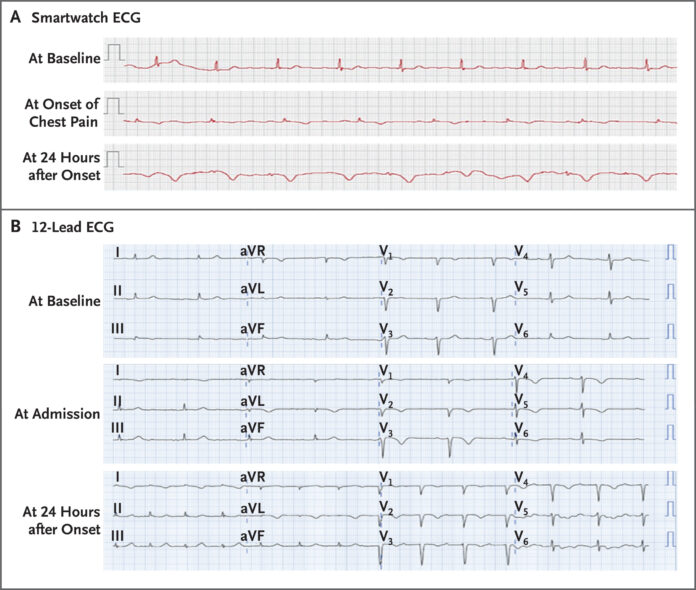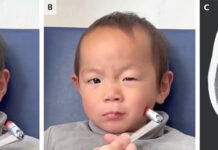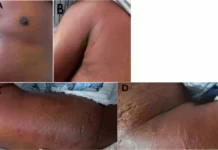Smartwatch-Detected Takotsubo Cardiomyopathy in a Retired Nurse: A Case Study
A 76-year-old retired cardiovascular nurse presented to the emergency department (ED) with a 2-hour history of acute chest pain. Following a highly emotional event. Notably, she self-reported ST-segment changes detected on her smartwatch’s electrocardiogram (ECG) feature, prompting urgent evaluation. Similarly, workup ruled out obstructive coronary artery disease, and she was subsequently diagnosed with Takotsubo cardiomyopathy, also known as stress-induced cardiomyopathy. This case highlights the evolving role of wearable technology in cardiac event detection, the unique clinical profile of Takotsubo cardiomyopathy. Moreover, the value of clinical intuition in healthcare professionals even after retirement.
Takotsubo cardiomyopathy, often termed “broken heart syndrome,” is a transient cardiac syndrome mimicking acute coronary syndrome (ACS), typically triggered by emotional or physical stress. It is more prevalent in postmenopausal women and accounts for approximately 1–2% of all suspected ACS cases. Wearable health technologies, such as smartwatches with ECG functionality, are increasingly playing a role in early detection and triage of cardiac events. This case explores a confluence of factors—clinical intuition, personal health technology, and psychosocial stress—culminating in a classic presentation of Takotsubo cardiomyopathy.
Case Presentation
A 76-year-old female presented to the ED complaining of central chest pain radiating to her jaw and left arm. The pain began 2 hours prior to presentation after she received news of her granddaughter’s involvement in a serious car accident. Similarly, her pain was described as “crushing,” with an intensity of 8/10, and was associated with diaphoresis and mild dyspnea. She denied any history of similar symptoms in the past.
Significantly, the patient had used the single-lead ECG function on her Apple Watch (Series 8) during the episode, which recorded ST-segment elevation in lead I and aVL. Concerned by this, and with her background in cardiology, she self-transported to the ED.
Past medical history included well-controlled hypertension and osteoarthritis. In addition to this, she had no history of coronary artery disease, diabetes, or hyperlipidemia. Medications included amlodipine and acetaminophen. She was a non-smoker, physically active, and consumed alcohol occasionally.
On arrival, her vital signs were stable: BP 136/84 mmHg, HR 76 bpm, SpO2 98% on room air, and RR 16. Physical examination was unremarkable with normal heart sounds and no signs of heart failure
Management and Outcome
She was admitted to the cardiac care unit for monitoring. Management included supportive therapy with beta-blockers (metoprolol), ACE inhibitors (lisinopril), and low-dose aspirin. Diuretics were not needed as there were no signs of volume overload.
Psychological support was also offered given the emotional trigger. A consult with psychiatry confirmed acute stress response but no underlying depressive disorder or PTSD.
The patient’s chest pain resolved within 24 hours. A repeat echocardiogram on day 5 of admission showed normalization of left ventricular function (EF 60%). She was discharged home with a cardiology follow-up and continued on low-dose metoprolol.
Takotsubo Cardiomyopathy is now increasingly recognized
Takotsubo cardiomyopathy is increasingly recognized due to better awareness and advanced diagnostic tools. First described in Japan in 1990, the condition is named after the octopus trap (“takotsubo”) resembling the ballooned shape of the left ventricle seen in imaging.
The pathophysiology is believed to involve catecholamine-mediated myocardial stunning due to excessive sympathetic stimulation during stress. Postmenopausal women are particularly vulnerable, likely due to estrogen deficiency and its role in modulating the cardiovascular stress response.
This case is notable for the patient’s proactive use of wearable ECG technology. Several studies have validated the Apple Watch ECG for atrial fibrillation detection, and emerging literature suggests its potential in identifying ischemic changes. However, its single-lead configuration limits specificity and must be corroborated with clinical and diagnostic evaluation, as demonstrated here.
Interestingly, the patient’s clinical background as a nurse may have influenced her prompt recognition of symptoms and decision to seek care, emphasizing the enduring impact of medical training.
Conclusion
This case illustrates the classic presentation and favorable prognosis of Takotsubo cardiomyopathy, reinforced by the timely use of wearable ECG technology and the patient’s clinical awareness. It underscores the value of integrating personal health monitoring with clinical evaluation and supports the growing role of smartwatches in bridging prehospital assessment and early intervention.
References




